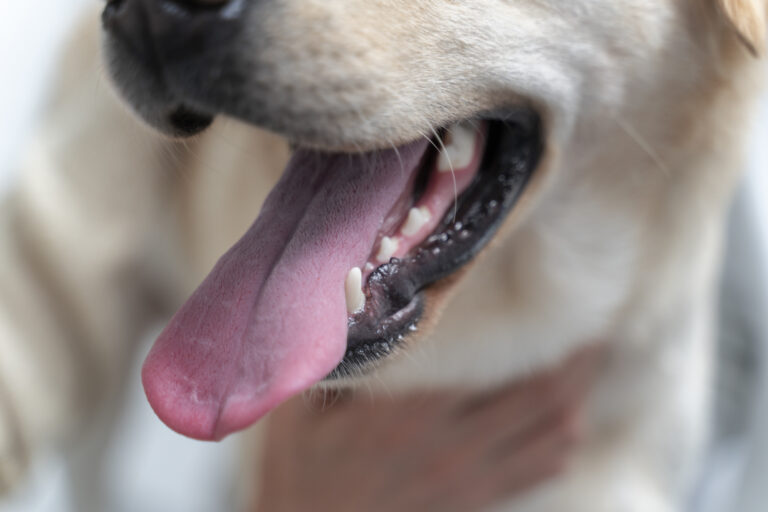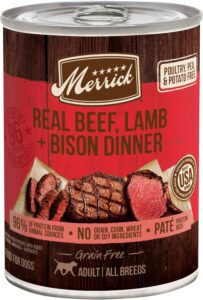
Disclaimer: The content in this article is for informational purposes only and is not a substitute for professional veterinary advice, diagnosis, or treatment. Always seek the advice of your veterinarian with any questions you may have regarding your pet’s medical condition.
Your vet keeps mentioning it. You know it’s important. Heck, you’ve probably read our guide on dog dental health and understand that brushing is the gold standard for preventing painful dental disease.
But here’s the reality: your dog acts like you’re approaching them with a medieval torture device every time you pull out that toothbrush.
Sound familiar? You’re definitely not alone in this struggle. I’ve talked to countless pet parents who describe tooth brushing sessions as “wrestling matches” or “complete disasters.” Some have given up entirely, convinced their dog will never tolerate it.
Here’s the thing though – most dogs can learn to accept, and sometimes even enjoy, having their teeth brushed. The secret isn’t forcing it or hoping they’ll just “get used to it.” It’s about taking your time and making the whole experience positive from the start.
This guide breaks down exactly how to do that, with a step-by-step training approach that builds trust instead of fear. No wrestling required
Getting Your Gear Right: Why the Tools Matter
The 5-Step Training Plan: Patience Pays Off
Before we dive into training, let’s talk equipment. Using the right supplies isn’t just about making things easier – it’s literally about keeping your dog safe.
The Toothpaste Situation
This one’s non-negotiable: never, ever use human toothpaste on your dog. I can’t stress this enough. Human toothpaste contains ingredients like xylitol (an artificial sweetener that’s toxic to dogs) and fluoride, which can cause serious stomach upset when swallowed.
Dog-specific toothpastes are formulated to be completely safe if swallowed – which they will be, since dogs don’t exactly master the “rinse and spit” technique. Plus, they come in flavors dogs actually enjoy, like chicken, beef, or peanut butter.
What works well: Enzymatic toothpastes are particularly effective because they contain special enzymes that help break down plaque even after brushing is over. Look for non-foaming formulas, which are easier for dogs to handle.
Check out our 5 Best Dog Toothpastes on Amazon (2025 Review)
Choosing Your Brush
Your brush choice depends on your dog’s size and how comfortable you both are with the process.
For beginners: Finger brushes are fantastic starting points. These soft, rubbery caps fit over your finger, giving you better control and allowing your dog to get used to the sensation gradually. Many dogs find them less intimidating than a traditional brush.
For efficiency: Once your dog is comfortable, double-headed brushes or 360-degree toothbrushes can clean more effectively. The angled design helps you reach different tooth surfaces without having to maneuver as much.
Size matters: Make sure whatever you choose fits your dog appropriately. A tiny finger brush won’t be effective on a Great Dane, and a large brush will be overwhelming for a Chihuahua.
Check out our Top 5 Toothbrushes on Amazon Review Guide
Here’s where most people go wrong – they try to accomplish a full tooth brushing session on day one. That’s like expecting someone who’s never driven to immediately navigate downtown traffic.
Instead, we’re going to break this down into manageable steps. Spend a few days on each step, keeping sessions short and positive. Trust me, this “slow and steady” approach will get you to your goal much faster than trying to rush things.
Step 1: Master the Mouth Touch
Your goal: Get your dog completely comfortable with you handling their mouth and lifting their lips.
Start when your dog is relaxed – maybe after a walk or during a calm evening moment. Sit beside them rather than looming over them (which can feel threatening).
Begin by simply petting their head and muzzle area while speaking in a calm, happy voice. After they’re comfortable with this, try gently lifting their lip for just a second or two. The moment you do this, reward them with enthusiastic praise and maybe a small treat.
Keep these sessions very brief – we’re talking 30 seconds to a minute. The goal is to end on a positive note every time.
Continue this for several days until your dog seems completely unfazed by lip lifting. Some dogs pick this up in a day or two; others might need a week. Go at your dog’s pace.
Step 2: Make Toothpaste the Best Thing Ever
Your goal: Get your dog excited about the taste and texture of their toothpaste.
Put a small dab of dog toothpaste on your finger and let your dog lick it off. Most dogs love the flavors, so this step is usually pretty easy. Make a big deal about how wonderful they are when they do this.
Once they’re happily licking paste off your finger, try gently rubbing your paste-covered finger along a few of their teeth and gums. This mimics the brushing motion and gets them used to the sensation.
Keep doing this for several days until your dog starts getting excited when they see you reach for the toothpaste tube. You want them to think, “Oh boy, it’s toothpaste time!”
Step 3: Introduce the Brush (But Don’t Use It Yet)
Your goal: Help your dog see the toothbrush as just another way to deliver their favorite paste.
Put some toothpaste on the brush and simply let your dog lick it off. Don’t try to brush anything yet – we’re just building positive associations.
You can try gently touching the brush to their front teeth for a split second before letting them have the paste, but don’t push it. The brush should equal “yummy treats,” not “scary procedure.”
Repeat this for several sessions until your dog is completely comfortable with the brush being near their mouth.
Step 4: The First Real Brushing (Keep It Tiny!)
Your goal: Successfully brush just one or two teeth without stress.
With paste on the brush, gently lift your dog’s lip and brush one or two of their large canine teeth (the “fangs”) for just a few seconds. Use gentle, circular motions and focus on the outer surface where tartar tends to build up most.
Here’s the crucial part: stop while you’re ahead. Even if your dog is tolerating it well, end the session after those couple of teeth. Give lots of praise and a special treat. You want them thinking, “That wasn’t so bad – and I got rewarded!”
Step 5: Build Up Gradually
Your goal: Work up to brushing all the outer surfaces of their teeth in one calm session.
As your dog becomes more comfortable, gradually increase the number of teeth you brush each session. Start with the canines, move to the premolars along the sides, and eventually include the big molars at the back.
A complete brushing session only needs to take about 60 seconds to be effective. You don’t need to spend 10 minutes scrubbing – short and consistent beats long and stressful every time.
Try to make it routine by brushing at the same time each day. Many people find success doing it right before dinner, since dogs start to anticipate and even look forward to the routine.
When Things Don't Go According to Plan
Let’s be real – not every dog follows the training plan perfectly. Here’s how to handle the most common roadblocks:
My dog clamps their mouth shut and won’t let me near it. This usually means you moved too fast through the steps. Go back to just touching their muzzle and rewarding that. Sometimes dogs need more time to build trust, especially if they’ve had negative experiences with mouth handling before.
Their gums bleed during brushing. Stop immediately. Healthy gums shouldn’t bleed from gentle brushing, according to veterinary dental specialists and clinical guidelines. A tiny bit of pink might indicate mild inflammation, but any noticeable bleeding suggests something more serious is going on. Time for a vet check.
They keep trying to bite the brush. This is often playful behavior, but it can make brushing impossible. Try holding the brush differently or using a finger brush instead. Some dogs do better when you distract them with the toothpaste flavor rather than focusing on the brush itself.
I can’t reach their back teeth. Don’t stress about this too much. The outer surfaces of the front and side teeth are the most important areas anyway. Your dog’s tongue does a decent job keeping the inner surfaces cleaner.
Making It Work Long-Term
The key to successful long-term tooth brushing is keeping your own energy positive. Dogs are incredibly good at reading our emotions, so if you approach brushing time feeling stressed or frustrated, your dog will pick up on that and respond accordingly.
Some days will be better than others, and that’s completely normal. If your dog seems particularly resistant on a given day, it’s okay to scale back to an easier step or even skip that day entirely. The goal is maintaining a positive association, not checking a box.
Remember, you’re not just preventing dental disease – you’re also strengthening the trust and bond between you and your dog. Every positive interaction around handling their mouth makes future vet visits easier too.
The Bottom Line
Teaching your dog to accept tooth brushing takes patience, but it’s absolutely worth the effort. Most dogs can learn to tolerate it, and many actually start to enjoy the attention and tasty toothpaste.
The secret is taking your time and making every step positive. Rushing the process usually means starting over, so embrace the gradual approach. Your dog’s teeth – and your relationship with them – will be better for it.
And hey, once you’ve mastered this, you’ll officially be able to say you can brush a dog’s teeth. That’s definitely a skill worth bragging about.
References
- American Kennel Club. “Xylitol Poisoning in Dogs: What It Is and How to Prevent It.” Available at: https://www.akc.org/expert-advice/health/xylitol-poisoning-in-dogs/
- Veterinary Oral Health Council. “VOHC Accepted Products for Dogs.” Available at: https://vohc.org/accepted-products/
- American Veterinary Dental College. “Brushing Your Pet’s Teeth.” Available at: https://avdc.org/avdc-recommendations/
- Gorrel, C., & Rawlings, J.M. (1996). “Effect of Frequency of Brushing Teeth on Plaque and Calculus Accumulation, and Gingivitis in Dogs.” Journal of Small Animal Practice, 37(8), 386-393. doi: 10.1111/j.1748-5827.1996.tb02433.x
- Bellows, J., Berg, M.L., Dennis, S., et al. (2019). “2019 AAHA Dental Care Guidelines for Dogs and Cats.” Journal of the American Animal Hospital Association, 55(2), 49-69. doi: 10.5326/JAAHA-MS-6933



